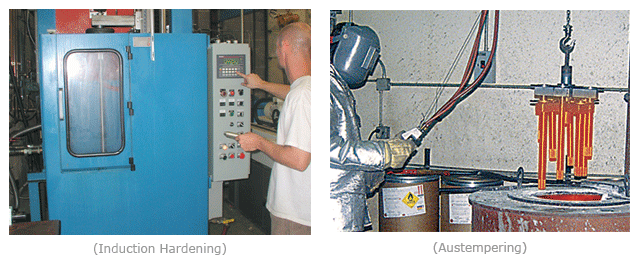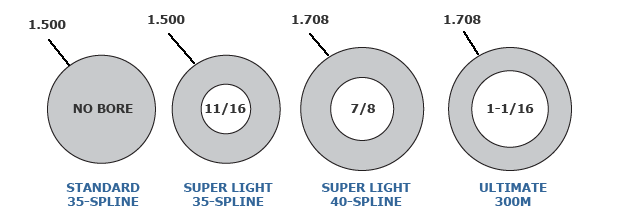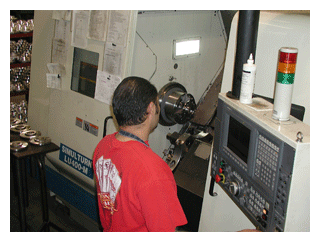Toll Free: 1-866-508-6394
OR Contact Us
OR Contact Us
Shop by Category

Believe it or not, there are at least a dozen things you should evaluate before purchasing axles for your race car or street machine. Our objective is to give you as much information as possible, which will enable you to make an educated decision.
The first thing you will be asked if you call a Mark Williams Enterprises tech-rep is "what is the application?" That's because an axle that's engineered to withstand the punishment of a 2500 horsepower Pro Mod drag car would be total overkill for a street or bracket racing application. The amount of torque load that an axle can be subjected to at launch can be estimated by taking the engine torque, multiplying that by the transmission's first gear, and the again by the rear end ratio. A Pro Stock car is capable of generating about 10,000 ft. lbs. of torque to the axles (5000 ft lbs to each).
Owners of cars that turn the quarter-mile in 10-seconds or slower should consider the economical MasterLine series of axles. Anything quicker should be equipped with Hi-Torque series axles that are available in 4340 and 300M hi-strength steel.
Size does matter when it comes to axles. The higher the spline count, the larger the diameter of the axle. The larger the diameter, the stronger the axle. Most current axles are based on a 24/48 diametrical pitch. A 35-spline axle has a major diameter of 1.500"and a 40-spline axle is 1.708 inches in diameter. Here's a handy strength chart for comparison, using the GM 12-bolt as a baseline:
| Number of teeth | Common Application | Major Diameter | % Change in Diameter | % Change in Strength |
| 28 | GM 10-bolt, 8.8" Ford | 1.208" | -6.9% | -19.3% |
| 30 | GN 12-bolt | 1.291" | -- | -- |
| 31 | 9" Ford | 1.333" | 3.5% | 10.7% |
| 35 | Racing | 1.500" | 17.2% | 61.2% |
| 40 | Racing | 1.708" | 34.5% | 143.2% |
It's important to note that all axles with similar spline counts are NOT necessarily the same. That's because the splines are machined with different pressure angles. Mark Williams axles and their mating spools are splined with a 45° pressure angle -many others utilize a 30° pressure angle, which is narrower at the base and deeper cut, which creates a weaker axle because of the smaller minor diameter. The 45° pressure angle is proven to be better for racing applications.

All OEM axle differentials have involute splines; their face is slightly curved to provide optimum contact and even pressure distribution during acceleration. Some aftermarket axles are made with straight-cut splines. They are not a correct engineering design and result in sloppy fitting practices. This creates high stress points, which can result in premature spline failure. Only involute spline profiles should be used to assure uniform loading and proper mating properties with spools and OEM components. In an exclusive process, splines on MW axles are hobbed while in the lathe-turning process. An MW designed (patent pending) hob attachment does the splining process in the same chucking operation as the turning. This produces extremely accurate splines that are true with the entire shaft.

There are a number different material used to make axles. Most OEM axles are made from carbon steel, (typically SAE 1055 or 1541) and relatively brittle. When high impact torque loads are placed on them they can snap. There are some who use these materials for their so-called "high performance"axles. Beware! Mark Williams Enterprises uses a quality High Manganese steel for its MasterLine series of axles and a more durable Nickel-Chromium-Molybdenum alloy for the Hi-Torque series. A 300M alloy is also offered for extreme duty use.
MASTERLINE: The strength of a component is greatly influenced by the manner in which the material is heat-treated. A double heat treat induction hardening process is employed for the MasterLine axles. The axle is passed through an electromagnetic coil that excites a powerful current within the shaft, thereby heating it and simultaneously quenching the axle to full hardness. Following the heating and quenching process the axle is tempered in special salt-heated draw furnaces to reduce brittleness and increase ductility.
HI-TORQUE AXLES: A process called Austempering is used for MW Hi-Torque axles. Unlike ordinary heat-treating, which uses a furnace to heat the item and then quenches parts in water or oil —which obtains a Martensite structure—MW heats the axles in a special salt bath vertical furnace and quenches them in a bath of lower temperature molten salt. This Austempering process results in a Bainite metallurgical structure, which produces a stronger, more ductile (with less distortion) microstructure. The process is time-consuming and more expensive than other methods, but it vastly improves ductility, which is the axle's ability to absorb impact and rebound. Both the Induction Hardening and Austempering processes are done in-house at MW to assure total quality control.

Some manufacturers, in an effort to cut costs, "gang run"quantities of axles with very long splines. Then, they merely chop off the required amount of spline to get the desired length. Accordingly, some axles have very long splines (which weakens it) or very short splines (which compromises engagement). You should know that each and every MW axles is individually made and has the optimum spline length for the application. No short cuts here!

Here's another place where bigger is better. MW pays special attention to maintaining the proper balance of axle spline size to bearing diameters. The larger the wheel bearing bore, safer the axle is in preventing flange loss. A stock 12-bolt Chevy uses a 1.400"i.d. bearing, while the small Ford is 1.378". Both of those sizes are too small for a racing axle. The mid-range performance axles use a 1.562"i.d. bearing, MasterLine series, while most Hi-Torque axles uses a 1.774"(45 mm) i.d. bearing. You should know that MW 35-spline axles with large bearings can be used with many OEM style housings. MW also produces many special housing ends that use larger axle bearing while still retaining OEM. brake systems.

The flange on a stock 12-bolt axle has a .320"thickness and sharp corners where it merges with the bearing surface. By contrast, an MW MasterLine axle has a .438"thick flange and employs a smooth transition to the shaft. This is obviously much stronger. Increasing the strength of the axle flange area is a paramount consideration for racing axles, and is of greater importance when using increased-offset racing wheels.

Each and every MW axle is individually designed for the customer's exact application. There are no compromises. One important facet is to incorporate a reduced diameter after the spline. This undercut and shaft taper enables the axle to function somewhat like a torsion bar and allows the rotational wind-up to occur over a longer area. Axles made without the reduced diameter and taper can twist at the end of spline engagement and eventually fail at this point.

Reducing the weight of an axle can pay dividends in improving performance. For this reason, MW offers "Superlight"and "Ultimate"versions of its Hi-Torque axles. A 35-spline "Superlight"axle is gun-drilled 11/16"and has pocketed flanges. The 40-spline versions have a 7/8"bore, along with extensively milled flanges. The "Ultimate"Hi-Torque axles are made from 300M alloy forgings and are gun-drilled to a 1-1/16"bore. They are almost half the weight of a standard Hi-Torque axle.

It's important to note that MW goes to great lengths to make the finest quality axles on the market. The accuracy of the machine work is impeccable. When you install an MW axle it slides into place (big hammers are often required for the competition). The shafts are exceptionally concentric, and the bearing shoulder and axle flange and exactly perpendicular. This improves internal efficiency and facilitates optimum performance.

If you've done any comparative shopping you've probably noticed that MW axles are a little more expensive than the competition. There's a reason for this. They are made from better materials, have more extensive heat-treating, are individually designed for the exact application, and have standard features that others charge extra for. They are truly the class of the field. And when you do a feature-by-feature comparison, you'll see that MW is the best overall value. And besides, how much is it worth you to avoid driveline failures and keep your car from going on its lid?